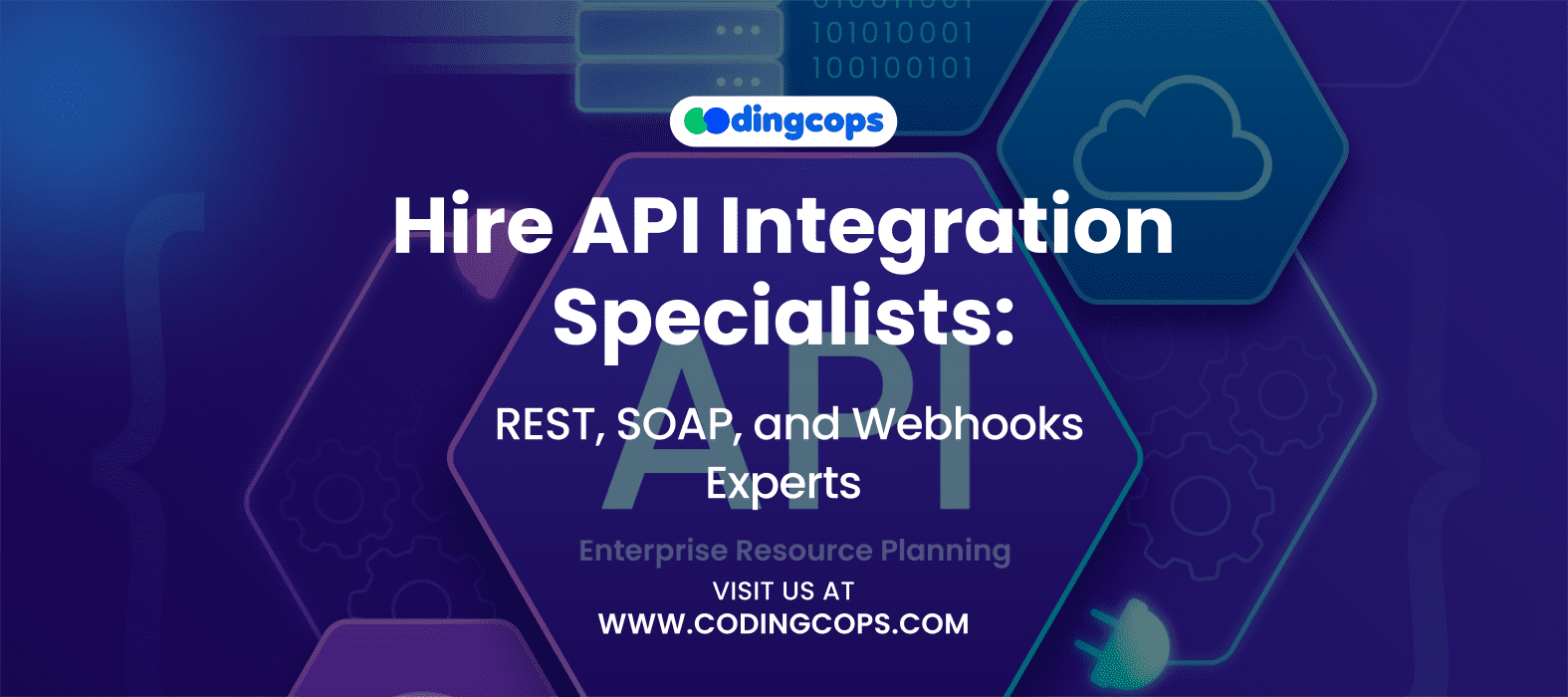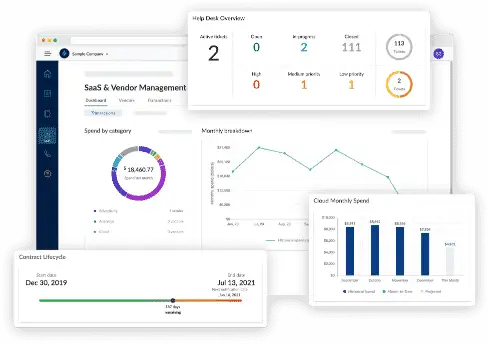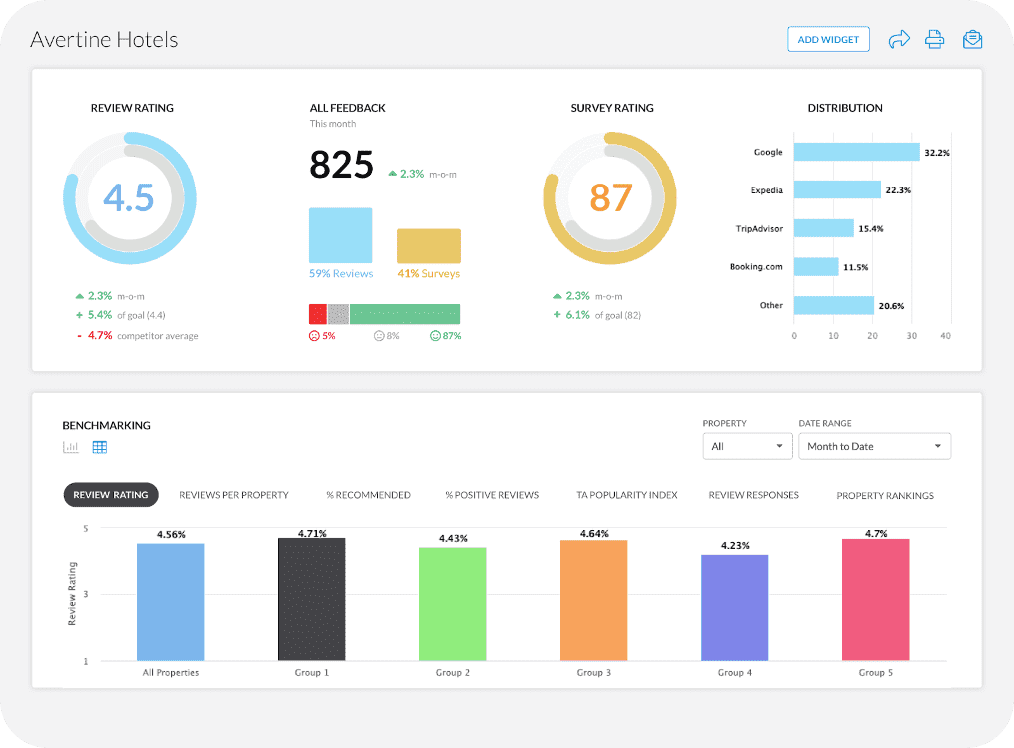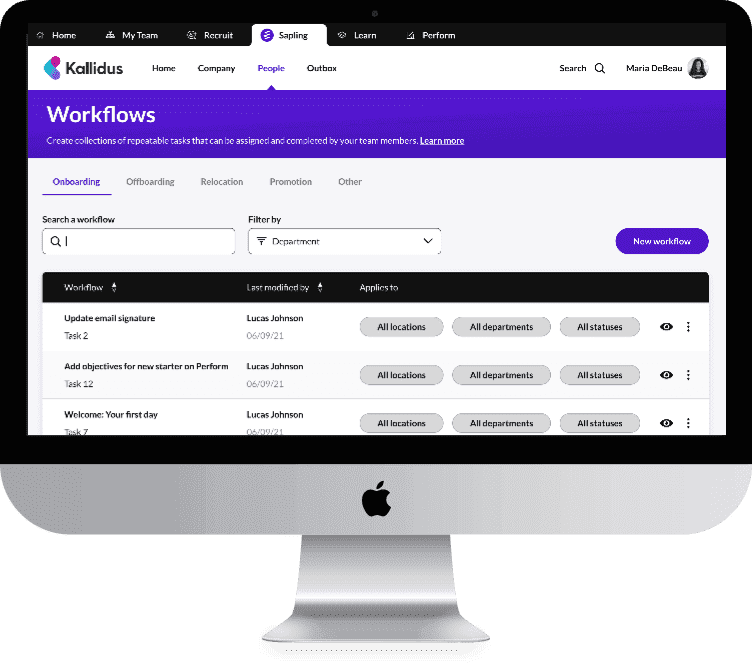According to BuiltWith, Firebase over 200,000 websites use Firebase, including over 94,000 in the United States alone. This is due to the fact that developers are always looking for solutions that will allow them to improve user experience and cut down on development time without sacrificing speed.
This is where Firebase, a comprehensive app development platform, has become the go to solution for mobile developers looking to simplify their workflow. Firebase offers a range of services designed to handle various aspects of app development, from real time databases and cloud storage to analytics and crash reporting.
In this guide, we will explore Firebase’s features and best practices to help you get the most out of this platform.
Firebase
Google created Firebase, a feature rich app development platform that offers a variety of cloud tools to assist developers in creating and refining their web and mobile apps. Firebase was acquired by Google and has since evolved into a reliable platform supporting the entire application lifecycle.
Moreover, Firebase is a Backend as a Service. This means it offers developers ready to use backend services such as authentication and databases. As a result, managing infrastructure and writing intricate backend programs are no longer necessary. In order to focus on developing frontend features and adding value for users, Firebase relieves developers of the burden of server side complexity.
Furthermore, Firebase’s real time data synchronization and platform interoperability make it especially well-liked among mobile app developers. Additionally, developers may utilize a single backend to construct cross platform apps due to its cross platform interoperability.
Another strength of Firebase is its integration with Google Cloud. This guarantees dependable security and performance. Firebase provides the architecture and tools to speed up development and successfully engage users, whether you are a development team working on a complicated application or a lone developer constructing an MVP.
Features of Firebase for Mobile Developers
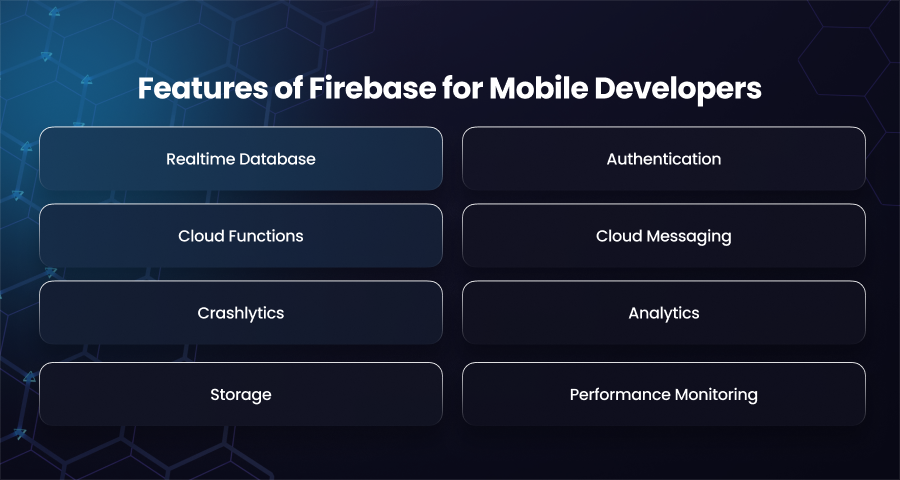
Realtime Database
Firebase offers two cloud hosted database options: the Realtime Database and Firestore. The Realtime Database is a NoSQL cloud database that stores data as one large JSON tree and allows real time syncing across clients. This means that any data change is instantly reflected on every connected device. Hence, it’s ideal for use cases like chat applications or collaborative tools.
On the other hand, Firestore is Firebase’s newer and more powerful database solution. Furthermore, it also supports real time syncing but provides a more structured and flexible data model based on collections and documents. Firestore supports advanced querying and automatic scaling, hence making it suitable for more complex applications.
Authentication
User authentication is a common requirement for mobile apps. Firebase Authentication makes it simple to implement. It supports a number of sign in methods. It also provides anonymous authentication, which lets people access your app without instantly creating an account. As a result, it’s an excellent tool for bringing on new people. Also, Firebase Authentication handles complex backend security and token management, reducing the burden on developers while ensuring secure access control.
Cloud Functions
You can utilize Firebase Cloud Functions to execute backend code in response to HTTPS requests and Firebase features. Since they are serverless operations, no infrastructure management is required. Your business logic just has to be written in JavaScript and deployed; Firebase takes care of the on demand execution. Automating processes like collecting payments and delivering welcome emails to users who have registered is made possible by cloud functionalities.
Cloud Messaging
You can send push notifications to both web and mobile users with Firebase Cloud Messaging. Targeting certain individuals or groups is possible with Firebase Cloud Messaging, and you can even set up notifications according on app events or user behavior. Implementing event driven marketing techniques that increase user engagement is made possible by their smooth interaction with Firebase Analytics. The ability to send warnings and data payloads gives developers total flexibility over how the app responds to incoming messages.
Crashlytics
Firebase’s lightweight Crashlytics assists developers in identifying and resolving stability problems that negatively impact user experience. It facilitates speedy root cause analysis by offering thorough crash reports and device information. Additionally, custom logs and keys are supported by Crashlytics. This enables developers to track specific app flows. Moreover, its real time alerting features notify you when a new issue arises or a known issue spikes in frequency.
Analytics
Deep insights into app use and user behavior are offered by Firebase Analytics. Additionally, it automatically records user activities like as screen views and program installations. Developers may also create custom events to track certain interactions. Product teams may utilize these insights to better understand how users are interacting with the app and make data driven choices.
Storage
Firebase Storage can hold large files, including images and videos. It provides secure file uploads and downloads regardless of network quality. Additionally, Firebase Storage manages caching and resumable uploads automatically. It is therefore perfect for mobile settings. Specific security rules and Firebase authentication manage access control.
Performance Monitoring
Developers can learn more about how well their apps operate in the real world with the aid of Firebase Performance Monitoring. It monitors parameters like screen rendering performance and app launch time. Developers may also establish performance warnings and examine performance trends. Teams can thus proactively improve the user experience and guarantee performance across devices and network circumstances by detecting the app’s sluggish areas.
Why Use Firebase in Mobile App Development?
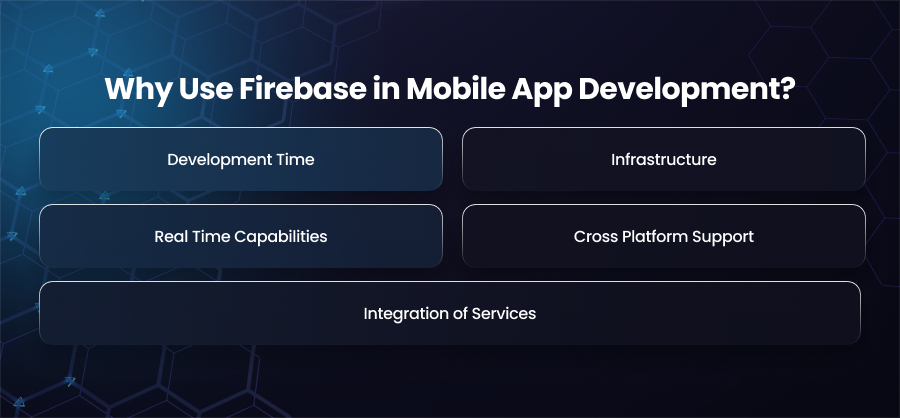
Development Time
Complex backend configuration is eliminated by Firebase’s pre-built and readily integrated services. Therefore, whether you want real time data syncing or user authentication, Firebase has solutions that you can use with only a few lines of code. The time needed to create and publish mobile apps is thereby significantly reduced.
Infrastructure
Firebase guarantees excellent speed and seamless scalability as your project expands since it is built on top of Google Cloud Platform. Firebase automatically grows its services to meet demand without the need for human intervention, regardless of how many users you are serving, hundreds or millions.
Real Time Capabilities
One of the Firebase’s standout features is its real time data synchronization. With the Realtime Database and Firestore, data updates are instantly pushed to all connected devices. Hence, this makes Firebase ideal for building dynamic apps and dashboards.
Cross Platform Support
Firebase supports multiple platforms, making it an excellent cross platform development solution. Developers can build apps for different platforms using the same backend infrastructure. Hence, this not only reduce development efforts but also ensures consistency in user experience and data handling across different devices. Firebase’s SDK are platform specific yet closely aligned in structure. This allows for easier learning and smoother transitions for developers switching between platforms.
Integration of Services
All Firebase services can work cohesively. For instance, you can use Firebase Analytics to monitor app use trends, integrate Firebase Authentication with Cloud Firestore to safely handle user data, and set off Cloud Functions in reaction to analytics events. Hence, this makes cloud development easy and effective.
How to Set up and Integrate Firebase?

Create a Project
In order to manage all of the Firebase services for your application, you should first start a new project. The project becomes the workspace where you may access features like databases and authentication when you build it.
App Registration
Once your project is ready, the next step is to register your mobile within Firebase. You can add Web and Android apps to a single Firebase project. The package name or iOS bundle, which uniquely identifies your software, is one of the crucial details you will supply throughout the registration process.
Configuration File
Following app registration, Firebase will create a configuration file with all the settings and login information required to link your app to Firebase services. This will be a plist file for iOS and a JSON file for Android. You should put this file into your app’s root directory. Hence, this step allows you to securely authenticate and interact with Firebase’s backend services.
Add SDKs
Firebase provides a collection of SDKs for different services like Authentication and Firestore. You should incorporate the appropriate SDKs into your mobile project based on the features you want. Usually, CocoaPods for iOS and Gradle for Android are used for this.
Initialize Firebase in Your App
Once you add SDKs and all the configurations are in place, you should initialize Firebase in your application. This tells your app to start connecting with Firebase services and allows you to begin using them. The initializing process typically occurs in your app’s startup lifecycle and can vary slightly between platforms. However, Firebase provides detailed documentation to guide you through it.
Configure Firebase Services
You can start activating and customizing certain Firebase services in accordance with the needs of your application after completing the basic integration. Also, you can choose your preferred sign in methods and set up user verification options. Moreover, you can set permissions and upload protocols for storing images or documents.
Test Your Integration
Before going live, it’s crucial to test the Firebase features you have integrated. The Emulator Suite, one of Firebase’s built-in technologies, allows you to replicate cloud operations and authentication in a local setting. This allows developers to test features without risking real user data or having to pay for them. Additionally, Firebase’s analytics and logging dashboards may help verify that data is being received and logged correctly.
Deploy and Monitor
Once testing is complete, your app is ready to be deployed. Firebase continues to provide value after launch through services like Crashlytics for real time crash reporting, and Analytics for understanding user behvaior.
Use Cases for Firebase Mobile Apps
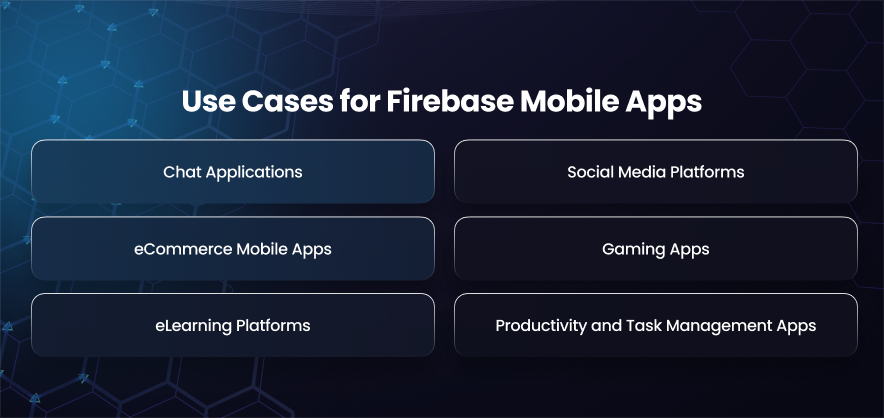
Chat Applications
You can build real time chat applications with Firebase. With Realtime Database or Firestore, developers can implement instant messaging features where messages appear live across all user devices. Hence, this makes Firebase perfect for chat apps and customer support platforms.
Social Media Platforms
Social apps require real time interactions and user generated content, both of which Firebase handles efficiently. Additionally, Cloud Storage can manage user generated material, and developers may manage Firebase Authentication for a smooth user sign in. Additionally, Firebase makes it easy to track user behavior using analytics.
eCommerce Mobile Apps
For eCommerce apps, Firebase provides a strong foundation to manage products and user accounts. With Firestore, developers can create dynamic product catalouges and manage cart data in real time. Also, Firebase Authentication secures user sessions, while Cloud Foundations can automate order confirmations.
Gaming Apps
Game developers often use Firebase to manage leaderboards and multiplayer syncing. Also, Firebase can store and retrieve player data and session histories with minimal latency. Additionally, testing and remote configuration may be utilized to test game levels or difficulty settings without releasing updates, while analytics aids in understanding player activity. You can also identify and fix flaws using Crashlytics, ensuring a seamless and entertaining gaming experience.
eLearning Platforms
Online learning apps can use Firebase to deliver interactive and scalable experiences. While Firestore holds course materials and assignments, Firebase Authentication assists in managing instructor and student logins. Additionally, Cloud Messaging makes it possible to send out timely notifications regarding impending deadlines or courses. Firebase’s real time capabilities support live quizzes and discussion forums.
Productivity and Task Management Apps
Firebase provides the real time synchronization required for smooth collaboration for apps centered on task management and productivity processes. Tasks may be created and updated by users, and all team members and devices instantaneously update with these changes. Hence, Firestone ensures data is structured and easily queryable, while Authentication keeps user data secure. Also, you can use Firebase Cloud Functions to send daily reminders automatically.
Final Words
Firebase’s reliable features and smooth service integration speed up mobile development. Chat apps, eCommerce, and productivity solutions are just a few of the many use cases it offers with scalability and security. Consequently, Firebase offers all the resources you want to create and enhance profitable mobile applications, irrespective of the size of your company.


